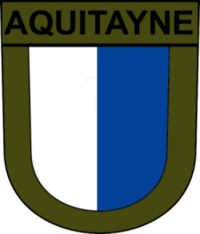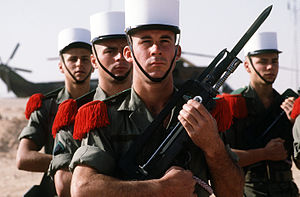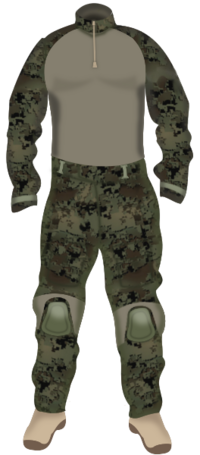Aquitaynian Foreign Legion
| Aquitaynian Foreign Legion | |
|---|---|
 Combat patch and Coat of Arms for the Legion. | |
| Active | June 26, 1924 - Present |
| Country | Aquitayne |
| Allegiance | |
| Branch | Army |
| Type | Elite Light Infantry |
| Size | 8,500 |
| Garrison/HQ | Ceria |
| Nickname(s) | 'Legion' |
| Motto(s) | Us Famblen Freir Tas |
| Colors | |
| March | The Legionnaire's Hymn |
| Anniversaries | June 26, 1924 April 17, 1943 |
| Engagements | |
| Website | legionnaire.info.aq |
| Commanders | |
| Notable commanders | Colonel Alexander Stark |
The Aquitaynian Foreign Legion (Grustyez Nyei Aqvitanye), is a contingent of the Aquitaynian Army that was established in 1924, under orders of Her Majesty Queen Lisa II, in hopes to bolster troop numbers before a large conflict involving regional powers. It has since participated in every armed conflict Aquitayne has been embroiled in, and will do so again whenever necessary. The Aquitaynian Foreign Legion is unique within Astyria, and indeed the world, due to the inherent nature of the legion; it is comprised solely of men and of which these men about 98% are from countries other than Aquitayne.
The Legion allows foreigners to escape their previous lives, for whatever reason, and begin anew within the United Kingdom. Upon enlistment to the Legion, it is a tradition as well as part of adherence to international law that the enlistee hand over his passport as the first item to be given to the Legion, signifying the closing of a chapter and the beginning of a new one. On the same night enlistees arrive at the Legion training center, they will observe the burning of each of their passports as they prepare to become Legionnaires.
History
The Aquitaynian Foreign Legion was created by Queen Lisa II, Queen of the Kingdom of Aquitayne, on the 26th of June, 1924. The purpose of this unit was to bolster the manpower of the Aquitaynian Royal Armed Services in what was perceived as an imminent invasion by the Exponential Empire. Queen Lisa II used the disruptive elements of society across Astyria, and the rest of the world, and used them to fight the enemies of Aqutiayne - which, at that time, was almost solely the Exponential Empire. Initial recruits trickled in from all across the globe; failed revolutionaries from the Greater Evil Imperial Japanese Dystopia, soldiers from disbanded Engollian mercenary groups, and persons with criminal pasts from almost any country.
The Aquitaynian Foreign Legion has been used almost solely by the respective Monarchs of Aquitayne to protect the colony of Cape Town in Insula Fera. Although the aforementioned territory had not been officially absolved into the Kingdom until 2014, the Legion - as a band of foreigners - was saught to be the respective group (until the 1940's) which would handle the protection of the territory. As a detachment of the Aquitaynian Army, the Foreign Legion saw action across Astyria in multiple conflicts. It would survive multiple armed conflicts, rebellions, two regional wars, and the relocation of their base in Ceria.
Colonization of Insula Fera (1897-2013)
While the colonization efforts of Insula Fera, and more specifically the region of Cape Town, extended back via the Royal Colonial Society to 1897, it would not be until the formation of the Legion in 1924 that Aquitayne would retain a military presence on the island. Given the 30 year differential and assimilation for Aquitaynian-Bhutan relations, the Bhutanese tribe agreed to allow Aquitaynian troops onto their territory, as the Legion was comprised of individuals who were from multiple nationalities than that of Aquitayne.
The mountainous regions of the northern areas of Cape Town would serve as the home for the Aquitaynian Foreign Legion for more than 40 years. The fort, Fort Kral'man, would see over 30,000 Legionnaires pass through its halls in its lifetime before it was decommissioned in 1969 as part of a demilitarization push by the Bhutan leadership. As of May 2nd, 2014, the Legionnaires have officially raised the Aquitaynian flag at Fort Kral'man for the first time in almost 50 years.
Battle of Barents Bay (1942)
The Battle of Barents bay occurred in 1942 when a group of rebellious Bhutan natives gathered to attempt to reclaim the city of Cape Town from the Legionnaires. The Legion had been tasked with protecting the city from pirates, and under an agreement established with Bhutan leadership, the Legionnaires were responsible for the protection of the city and its people. When the natives decided to assault the city in the name of recourse, this policy was put into action.
The battle lasted roughly five days, and saw the lives of roughly 100 Legionnaires lost. It is one of the bloodiest battles the Legionnaires have fought in its history and remains one of the most celebrated. It is seen not only as a triumphant victory among the ranks of the Legion, but also as the ultimate sacrifice from those who lost their lives for the people of Cape Town, and only acted to solidify the relations of the two countries.
The famous 'Barent Charge' was displayed in this battle. The charge was lead by Battery Sergeant Hubert Hallman, and resulted in his own death and the death of all those that followed him. Even so, the charge routed the enemy encampment and assisted in securing the overall victory against the assaulting rebels. It is seen in Legionnaire history as the most selfless and glorious acts a Legionnaire can perform.
Humanitarian Intervention in Pangus & Prudenesia (2014 - Present)
Membership
Currently, the Aquitaynian Foreign Legion accepts individuals with criminal backgrounds. The current policy of the Legion is:
Reportedly, there have been numerous exceptions to this rule when it comes to certain nationalities, as well as the circumstances of the crimes being waged. For instance, an individual who has committed murder under conditions where it was not amiable will not be recruited, whereas an individual who's circumstances dictated killing will be granted a fair chance at enlistment.
The Foreign Legion is the only unit of the Aquitaynian military that accept persons of foreign nationality. Still, most Legionnaires come from Astyrian countries, while a growing number of individuals are enlisting from other regions across the globe. Around 98% of Legion officers are of Aquitaynian descent.
Throughout the Legion's history, enlistees are required to initiate the application process under their real name. However, whence they have arrived at basic training, their passports are seized and they are given a pseudonym ("declared identity"). This allows the individual to escape from any type of legal, personal or otherwise recourse they may face in their home country. While these individuals are no longer a citizen of their nation of origin, they are likewise not a citizen of Aquitayne; they are what is called, "Gyet Mo'rhava", or, "Children of the Lost Land". They are protected under a provision signed by Queen Lisa II, which gives them rights of travel and basic provisions under the Aquitaynian Rule of Law.
After a Legionnaire has served 3 of his 5-6 year contract, he may apply for Aquitaynian citizenship. Given that the authorities in his home nation are not attempting to serve an extradition warrant on his former or current identity, and that this Legionnaire has served with, "honor and devotion", he will be granted full Aquitaynian citizenship. Furthermore, a soldier who becomes injured - or killed - in a battle for Aquitayne may immediately apply for citizenship under a provision known as "Aqvitanye as tyet mrohyei los" (Aquitaynian by spilled blood).
There has never been any women within the Aquitaynian Foreign Legion throughout its history, and remains today the only unit within the Aquitaynian military which does not allow women within its ranks.
Membership by Country
Currently, the Legion is composed of individuals from over 85 countries. Most of the enlisted personnel of the Legion are of foreign descent, while the Officer Corps of the Legion is almost solely Aquitaynian nationals. This composition has been upheld since the founding of the Legion, under the belief that, "to become an Aquitaynian, one must truly be taught, trained, and mentored by one".
Traditionally, the membership of the Legion reflects the trials and tribulations of Astyria during that time period. While there are no official statistics for the enlistment of certain nationalities, there are foreseeable rises and declines in the rate of admissions to the Legion depending on the circumstances of the stability of Astyria at any given year. After GAWI, the Legion saw an influx of volunteers to the point where the Legion grew from only a single company of men to well over a Brigade. Many believe there is fact to reports that during GAWI the Aquitaynian Foreign Legion actively recruited within the POW camps of multiple nations.
After the fall of the Exponential Empire, Sir Garilus Carus pondered the notion that the Aquitaynian Foreign Legion was almost solely comprised of Confederate soldiers, stating that:
[the] righteous tribulations of what is known to be the Foreign [Legion] must be endowed only to their enemies; it is rightly the assumed perception that the Legion, in its efforts to bolster a defense against the Exponential lineage, has indeed created within its ranks its own lineage of Exponential descendants. Even supposing that the Aquitaynian recruiters (in their noble efforts) did not care to discriminate against the ethnicity's they were being asked to forego, and assuming that their sole purpose was to bolster the numerical odds of this Legion, it cannot be denied that the true makeup of the ranks of this Legion cannot be confuted to be anything but Conurbii and Expontetiallian.
If even it were so that the recruits of this decade were not of Exponential origins, and that they were realistically from the other realms and states of this region, what are they to be? Where other than the fall of an Empire does a Legion such as ours garner the numbers it now boasts to the world? There is no further insurrection; there is no further civil strife; no further act of revolution other than the one to which we have bore witness, and to that event we see the insecurity of a nation and the desperate acts of the lower class, the fighting man, to seek fortune elsewhere in a realm which sparks stability and irrefutable future.
Are we not, then, keen to assimilate these folk to our kin? Or are we of the mindset that an oppressor long past is too in the living mind of the people of the modern age? I say fear not the overthrow of [the] Legion; the Officers of our Realm have done well to make these folk our own, and in that righteous duty they have become our kin.
Ranks
Traditions of the Legion
Due to the Legion being comprised of soldiers of different backgrounds, it needed to develop a very intense Esprit de Corps, which is carried out by the development of camaraderie between the recruits in their initial phases of training; furthermore, it needed to instill a high sense of loyalty to the Legionnaires, and the pride of being a member of an elite unit.
Code of Honor
Every trainee must know by heart the Legionnaire's Code of Honor. During training, it is the first thing recruits recite when waking up and the last thing the recruits will say before they go to sleep.
| Vik'Rus | English |
|---|---|
|
|
Composition
Current Deployments
- External Operations or OPEX (other than at home bases or on standard duties)
- Insula Fera Humanitarian Mission in support of Operation New Dawn - Aid - 1e REG ; 1e PAR
- Insula Fera Humanitarian Mission in support of Operation New Dawn - Prevention - 2e REG ; 1e REC ; 3e CEA company
| Acronym | English Meaning | |
|---|---|---|
| CEA | Reconnaissance and Support Company | |
| CAC | Anti-Tank Company | |
| UCL | Unit of Command and Logistics | |
| EMT | Tactical Command Post | |
| NEDEX | Neutralisation and Destruction of Explosives | |
| OMLT | Operational Monitoring and Liaison Team | |
Special Forces
While the Legion does not officially have Special Operations Forces within their unit, they do have multiple units which act in a role which is traditionally reserved for special forces. Unlike other units across the military, the Legion does not have a Kommandosow Brigade, and therefore is resigned to train its own paratroopers. These Legionnaires are trained to the exact same standards as the Kommandosow, and are sometimes even placed in the same training cycle as regular Aquitaynian Army personnel; however, the Legion does retain its own training regimen for all military occupational specialties. Notably, the Legion's Sniper program is much different than that of the Army.
The 1st Mountain Regiment and 1st Parachute Regiment both contain a unit of elite commandos for each Battalion under the command of these Regiments, including the Legion's Second Foreign Parachute Regiment, and the Second Foreign Engineer Regiment.
Each Battalion is also assisted by trained Legionnaire snipers, which are notorious for undergoing brutal training regimens and being held to standards even higher than their Aquitaynian counterparts in the Army. To date, the last 24 of the 49 Multibranch Sniper Tournaments that the Legion has been permitted to have taken part in since 1965, have been won by Legionnaires.
There is also an elite Amphibious EOD and Pathfinding unit that is within 1REG, called "Preikan Cruso Grup" or "PCG".
Uniforms and Equipment of the Legion
Uniforms
| Flag Staff (General Officers) | Junior Officers | Enlisted | Ceremonial Dress |
|---|---|---|---|
Combat
The Foreign Legion is authorized to wear a myriad of different fatigues while in combat, and these choices are usually dictated by where the deployment is located, and that locations respect fauna. However, there are three common choices when dealing with general wear in Aquitayne whilst not deployed, as well as while deployed in-theater:
| MCP-Desert | MCP-Transitional | MCP-Woodland | MCP-Transitional Body Armor |
|---|---|---|---|

